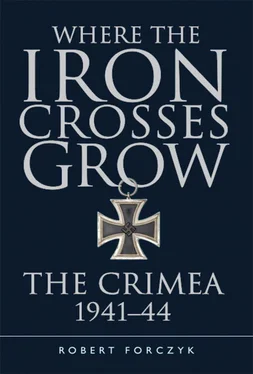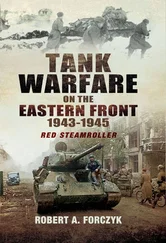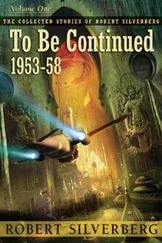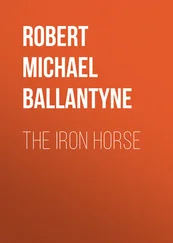The Tatar Khan reoccupied the position at Perekop but another Russian army led by the Irish-born Count Peter Lacy outwitted them again by crossing the Sivash in June 1737 and defeating the outflanked Tatar army. Lacy had discovered an important point about the odd terrain of the Crimea – that under the right conditions of wind and tide, the Sivash was briefly fordable. After these defeats, the military power of the Crimean Khanate fell into sharp decline.
A period of peace followed, but in 1771 conflict was resumed and Prince Vasily Dolgorukov, now a general, returned to Perekop at the head of a powerful army. Tatar resistance was much weaker than before and Dolgorukov easily stormed the Perekop fort on July 10, 1771. Once the defenses at Perekop were breached, the Khan fled to Constantinople and much of his army evaporated. Prince Dolgorukov overran the Crimea in a month, although Tatar survivors retreated into the mountains on the southern coast. He was awarded a title recognizing him as conqueror of the Crimea. [5] Milner, The Crimea: Its Ancient and Modern History: the Khans, the Sultans, and the Czars , pp. 220–222.
Subsequently, the Treaty of Kuchuk Kainarji with the Ottoman Empire in 1774 recognized the Russian military successes and allowed the nearly defunct Crimean Khanate to be recast as a Russian puppet state. However, the Russian-appointed Khan was rejected by the Tatar people, many of whom retreated into the southern mountains to conduct a guerrilla war. Up to 30,000 Tatars may have been killed during this period of Russian quasi-occupation, but years of guerrilla warfare also strained the Russian Army. After nine years of this nonsense, Catherine the Great finally decided to annex the Crimean Khanate outright in April 1783. She put her lover Prince Grigoriy Potemkin in charge of the region and he encouraged Tatars to leave the Crimea for Ottoman lands; 80,000 left in 1784. [6] Milner, The Crimea: Its Ancient and Modern History: the Khans, the Sultans, and the Czars , p. 279.
Catherine also ordered the deportation of 75,000 Greek Christians from the Crimea and invited colonists from her native Germany to move to the Crimea. Russian rulers since Peter the Great had invited skilled foreigners to come to special economic zones to rapidly build up commerce, and the Crimea was expected to become a rich province.
An expatriate Scot by the name of Thomas F. Mackenzie (1740–86) was in command of the main Russian naval squadron in the Black Sea, and on his own initiative he selected the harbor near the Tatar village of Aqyar as an excellent site for a naval base. In June 1783, crews from Mackenzie’s frigates began constructing naval barracks and other shore facilities in the port that would soon be renamed Sevastopol by Prince Potemkin. Another nearby harbor, at Balaklava, was also selected for development. Although the “base” was little more than an undefended roadstead outfitted with a few piers and warehouses, Potemkin announced the formation of the Black Sea Fleet ( Chernomorsky Flot ), from Mackenzie’s naval squadron. [7] W. Bruce Lincoln, The Romanovs: Autocrats of all the Russias (New York: Anchor Books, 1981), pp. 233–235.
Another foreigner serving with the fleet at Sevastopol was the American John Paul Jones, who commanded one of Mackenzie’s frigates. Mackenzie himself passed quickly from the scene but left a lasting legacy in Sevastopol. It was not long before annexation of the Crimea brought renewed war with the Ottoman Empire, but the Black Sea Fleet, under the capable leadership of Admiral Fyodor Ushakov, handily won a string of naval victories against the Turks between 1788 and 1791. By the end of the 18th century, possession of a warm-water port in the Crimea enabled Russia to become the dominant naval power in the Black Sea.
Due to the remoteness of the Crimea, it took many decades to actually build an effective naval base at Sevastopol. All materials had to be brought in by vessels, across the Sea of Azov, from Rostov. Most of the labor force was comprised of local serfs, who had few tools for digging or construction, but the number of skilled foreigners imported into the Crimea increased significantly after 1805. A cluster of German colonies was built around Neusatz-Kronenthal, 12 miles west of Simferopol, which slowly grew to over 11,000 Germans over the course of the 19th century. [8] John N. Lenker, Lutherans in all lands: the wonderful works of God, Volume 2 (Milwaukee, WI: Lutherans in all Lands Company, 1896), pp. 450.
It was not until the reign of Tsar Nicholas I (1825–55), that a serious construction effort began to equip Sevastopol as a fully functional naval base. An English engineer, John Upton, was brought to Sevastopol in 1832 to head a five-year project to complete the first dockyard and to design a string of forts around the port. [9] The Nautical Magazine and Naval Chronicle for 1855, Volume 24 (London: Simpkin, Marshall and Co., 1855), pp. 581–582.
However, Upton’s project took two decades to complete and the first Russian warship could not use Sevastopol’s dockyard until 1853. Nevertheless, possession of the Crimea and a nascent naval base at Sevastopol emboldened the tsars to consider further expansion at the expense of the Ottoman Empire, since Ottoman naval superiority was no longer unchallenged.
Yet the build-up of the Black Sea Fleet and the naval base at Sevastopol contributed to tensions with Britain and France, which supported the Ottoman Empire. When another war erupted with the Ottomans, a Russian naval squadron led by Admiral Pavel Nakhimov easily crushed an Ottoman squadron at the battle of Sinope in November 1853, but this served as justification for Britain and France to declare war on Russia four months later. It is revealing that the primary objective of the Anglo-French expeditionary forces in the subsequent Crimean War was to destroy the Russian Black Sea Fleet and its base at Sevastopol, which were regarded as the Russian “center of gravity” for further aggression against the Ottomans. The year-long siege of Sevastopol destroyed Russian naval power in the Black Sea; most of the base was laid waste and 14 of 15 ships of the line and four of six frigates were scuttled in the roadstead. After the fall of Sevastopol to Anglo-French forces in September 1855, the Treaty of Paris, signed in March 1856, limited the Black Sea Fleet to only ten small warships with a maximum combined tonnage of 5,600 tons – less than 10 percent of its pre-war tonnage. The treaty also limited Russia’s ability to enlarge existing naval bases in the Black Sea and to construct new coastal fortifications.
Although Russia was angered by this punitive peace settlement, it was not until 1871 that Tsar Aleksandr II dared to abrogate the naval clauses of the treaty, but then left it to his son to begin rebuilding Russian naval power in the Black Sea during the 1880s. The weakness of Russia’s industrial base made the resurrection of the Black Sea Fleet a long, drawn-out process and it was not until June 1883 that the dockyard at Sevastopol was capable of beginning construction on the Ekaterina II -class pre-dreadnought battleships. Nevertheless, most warships of the Black Sea Fleet were still built at Nikolayev, not Sevastopol. Much of the German population that had supported development of the Crimea began to migrate to the United States after Tsar Aleksandr II decided in 1872 to remove their exemption from conscription into the Russian Army. More Russians were brought in to “Russify” the Crimea, but these also included disgruntled workers from cities that brought unrest with them. In June 1905, the Black Sea Fleet was struck by the mutiny of the crew of the pre-dreadnought battleship Potemkin , which then spread to other warships in the fleet. Although the revolt was eventually suppressed, it brought out an important political reality in the Crimea. Whereas agitation in the rest of Russia during the Revolution of 1905 was predominantly in the urban proletariat, the Crimean population was primarily agricultural and not disposed to revolution, but the sailors of the Black Sea Fleet were a nexus of unrest.
Читать дальше












